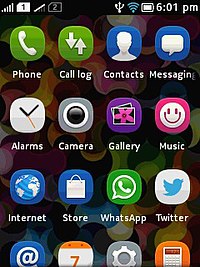
Back Nokia Asha platform Latvian/Lettish Asha Platform Russian Nokia Asha platform Turkish 诺基亚Asha平台 Chinese
 Main menu interface of the Asha platform | |
| Developer | Microsoft Mobile Oy (originally Nokia) |
|---|---|
| OS family | Mobile operating system |
| Working state | Discontinued |
| Source model | Closed source |
| Initial release | 9 May 2013 |
| Latest release | Asha Platform 1.4.0.6 |
| Marketing target | Entry-level smartphones |
| Available in | Multi-lingual |
| Package manager | .jad |
| Platforms | ARM |
| Kernel type | unknown, descendant of Series 40[1] |
| Default user interface | Nokia Fastlane, Swipe |
| Official website | Nokia Asha — Platform overview |
| Support status | |
| Unsupported | |
The Nokia Asha platform is a discontinued mobile operating system (OS) and computing platform[2] designed for low-end borderline smartphones, based on software from Smarterphone which was acquired by Nokia. The platform inherits UI similarities mostly from MeeGo "Harmattan", and replaced Series 40 on Nokia's low-end devices.[3] The user interface design team was headed by Peter Skillman, who had worked previously on webOS and the design of MeeGo for the Nokia N9.
It was the successor to the Meltemi project which Nokia was developing as a Linux platform to replace Series 40, but was cancelled in July 2012.[4]
The first phone based on the platform was the Nokia Asha 501, followed by the Asha 500, Asha 502 Dual SIM, and Asha 503, all announced at Nokia World in October 2013.[5] Another phone, the Nokia Asha 230 was announced on 24 February 2014, and came pre-installed with Asha platform 1.4.
Apps for the platform were either made using Java ME, or as web apps, which are rendered by the Nokia Xpress browser which uses the Gecko rendering engine.[1] The mobile operating system lacks true multitasking but the radio and music app can run in background mode (which is advertised as multitasking), while swiping to fastlane apps will actually close down previously opened applications instead of minimising them.[6][7]
It featured a notification centre, named Fastlane, which was accessible by swiping to the left of the home screen.
The platform was supplemented by the Nokia X software platform, Nokia's customised version of Android, seen on the Nokia X, which draws cues from the Asha platform, including the Fastlane notification centre.[8]
In a company memo released in July 2014, Microsoft announced that as part of cutbacks, they would cease all development of the Asha, Series 40, and X ranges, in favor of solely producing and encouraging the use of Lumia Windows Phone products.[9]
- ^ a b "Nokia Asha — Platform overview". Archived from the original on September 3, 2013. Retrieved September 4, 2013.
- ^ "Nokia unveils the touchscreen Asha 501 with new software platform, we go hands-on (video)". engadget.com. Retrieved 7 April 2018.
- ^ Sharma, Mahesh (2013-05-09). "Nokia launches $99 Asha phone, reveals new OS" (CSS3/IE7+). ZDNet. Retrieved 2013-10-26.
- ^ Reisinger, Don (2012-07-26). "Nokia quietly kills Linux-based Meltemi, report says" (CSS3/IE7+). c|net. Retrieved 2013-10-26.
- ^ "Nokia adds 500, 502 and 503 to its Asha lineup, starts at $69". engadget.com. Retrieved 7 April 2018.
- ^ Litchfield, Steve (2012-09-25). "Nokia's Asha Touch now 'officially' a 'smartphone' platform". All About Symbian. Retrieved 2013-10-26.
- ^ Faro-Tusino, Michael (2013-05-09). "Q&A with Stephen Elop on the Asha 501". My Nokia Blog. Retrieved 2013-10-26.
- ^ "Xtraordinarily xcellent: the Nokia X family". microsoft.com. Archived from the original on 25 July 2015. Retrieved 7 April 2018.
- ^ "Microsoft is killing off Nokia's feature phones in favor of Windows Phone". The Verge. 17 July 2014. Retrieved 17 July 2014.